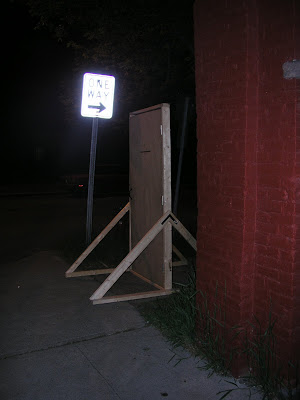 -Threshold at Adams Street and 3rd Street-
-Threshold at Adams Street and 3rd Street-
 -Threshold at Adams Street and 3rd Street-
-Threshold at Adams Street and 3rd Street-
"Thresholds" explores the invisible (sometimes not so invisible) boundaries that exist in urban spaces which separate the wealthy from the working class and poor and white people from People of Color.
To further illustrate this notion of thresholds in the city landscape a description of walking down a few blocks of downtown Troy, NY follows:
For example, a subtle boundary runs down the intersection of Third Street and Fulton Street to State Street. A person walking down Third Street from Fulton to State will find many different kinds of shops with people coming in and out and cafes with outdoor seating where people are hanging out. Upon crossing State Street the scene changes immediately, it becomes strangely more desolate. Except for the occasional congregation of homeless people and the elderly this half a block of Third Street between State and Congress Streets is empty. It’s not over yet, keep walking past the church and the boarded up building, past the parking lot and once again the scene changes. The street is bustling again as it was a block back. People are waiting for the bus, they are walking in and out of the unusually high concentration of convenience stores and mini markets, people are drinking coffee at the corner coffee shop, but it’s a different group of people then it was a block ago. The intersection of Third and Congress Streets is dominated by People of Color while a block before the people at the coffee shop and walking in and out of the pharmacy were mostly white. What happens in that strange half a block space between State and Congress where things get quiet? What happens in that quiet space of parking lots, abandoned building and single use buildings that stops the flow of people and keeps them separated?
Another boundary, this one being a rapid shift one, is the very small space that exists between the Washington Park neighborhood and the neighborhood known mostly as South Troy. This very small space of transition is a street called Adams. It is amazing how quickly things change. You walk past the park and see the renovated old mansions that surround the park which sits manicured, empty, and silent being watched only by windows. You walk through this neighborhood and do not see and single person. Everyone is inside I suppose. Keep walking up Third Street past the mansions and their carriage houses until you reach Adams Street and you are already in a different place. There are no more trees; the whole scene opens up to desolate looking houses in disrepair, there’s suddenly trash collecting at the curb, and there are people outside fixing their cars, there are children playing in the alleys. You can hear the chatter and the yelling from inside the houses to the people outside. You have crossed one street and the whole scene has effectively changed; architecturally this neighborhood is more rundown but people also seem to live here unlike the previous neighborhood where you could have been walking through a movie set, a street scene of trompe l’oeil facades with no one inside the houses, just a few sticks holding the scene up.
----------------------------------
Further exploration of the city as being striated by boundaries show that census data matched the experience described above almost precisely. Where the description explains a feeling of a shift in the city from simply experiencing it, the census data mirrored those shifts in its files and maps containing data on per capita income. On the census maps Adams Street is actually a border between one income bracket and another.
As a way of demarcating these boundaries in physical space a group of artists erected two free standing doors at the intersections between Second and Third and Adams Streets. The doors opened and closed like normal doors and sat in the middle of the sidewalk so people could walk through them. The doors had text on them which read, “I heard this was a good neighborhood on the side that would be approaching Washington Park if you were coming from South Troy. On the opposite side the text read “I heard this was a bad neighborhood.”
The city is striated with different thresholds that function as invisible borders throughout the city, thresholds whose permeability changes depending on your relationship to the space and other oppressive forces in our society such as binary gender identity, race, and class. Some people can cross these thresholds without a problem. Sometimes people from one side of the threshold can cross it without consequence yet when it is crossed in the other direction people are eyed suspiciously and they obviously “don’t belong.” These threshold/boundaries are very real manifestations of power that affect the flow and feel of the city though they themselves are invisible. Users of space see and sense the shift in the city landscape but they do not fully recognize they have passed from one space to the other. This intervention made that shift obvious in order to generate a discussion about the larger issues at play in space. Issues dealing with race and class and the greater social context as they manifest themselves through built space and script the scene.






















